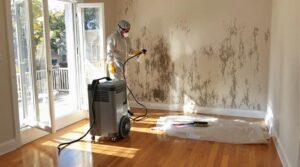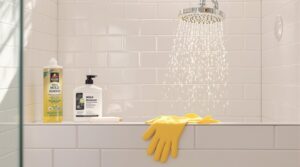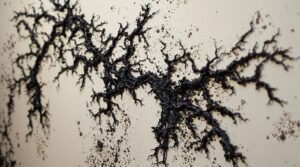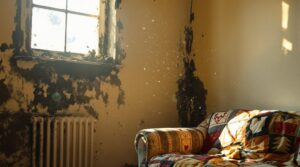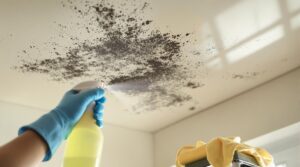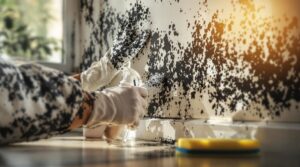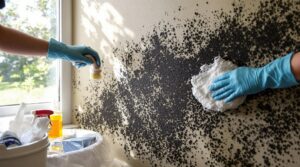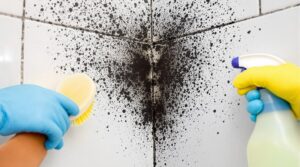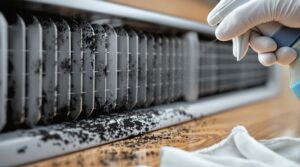Black mold identification in homes requires knowledge of its characteristics and growth patterns. Toxic black mold, *Stachybotrys chartarum*, appears as dark green or black patches with a slimy texture and musty odor, typically growing in damp areas like basements and bathrooms. Non-toxic black mold is less slimy and lacks a distinctive smell. Understanding the differences between toxic and non-toxic black mold is essential for effective remediation and health risk mitigation. Further exploration of black mold's risks and prevention strategies can provide valuable insights for homeowners.
Key Takeaways
- Toxic black mold is dark green or black, slimy, and has a musty smell, while non-toxic mold is less slimy and lacks a distinctive smell.
- Look for dark patches with a flat or fuzzy texture in damp areas like basements, attics, bathrooms, and kitchens.
- A musty odor resembling decaying organic matter is indicative of black mold presence.
- Toxic black mold thrives in consistently humid areas, while non-toxic mold grows on less moist surfaces.
- Identify potential growth areas and moisture sources through visual assessments to determine the risk of black mold growth.
Understanding the Risks of Black Mold
Because black mold poses a vital threat to human health, understanding its risks is essential for maintaining a safe indoor environment.
The primary concern is *Stachybotrys chartarum*, a species of black mold that produces mycotoxins capable of triggering severe health issues. Individuals with allergies, asthma, or compromised immune systems are particularly susceptible to the adverse effects of black mold exposure.
Symptoms of exposure include respiratory distress, skin rashes, and neurological issues. Prolonged exposure can lead to more severe health problems, such as lung disease and cognitive decline.
Not all black molds are equally toxic, but *S. chartarum* is a notable health risk. To mitigate these risks, it is imperative to identify black mold promptly and take action to remove it.
Understanding the risks associated with black mold is the first step in maintaining a safe and healthy indoor environment. Early detection and removal can considerably reduce health risks.
When spore counts exceed 75,000, immediate evacuation of the premises is necessary to protect occupant health.
Identifying Black Mold in Your Home
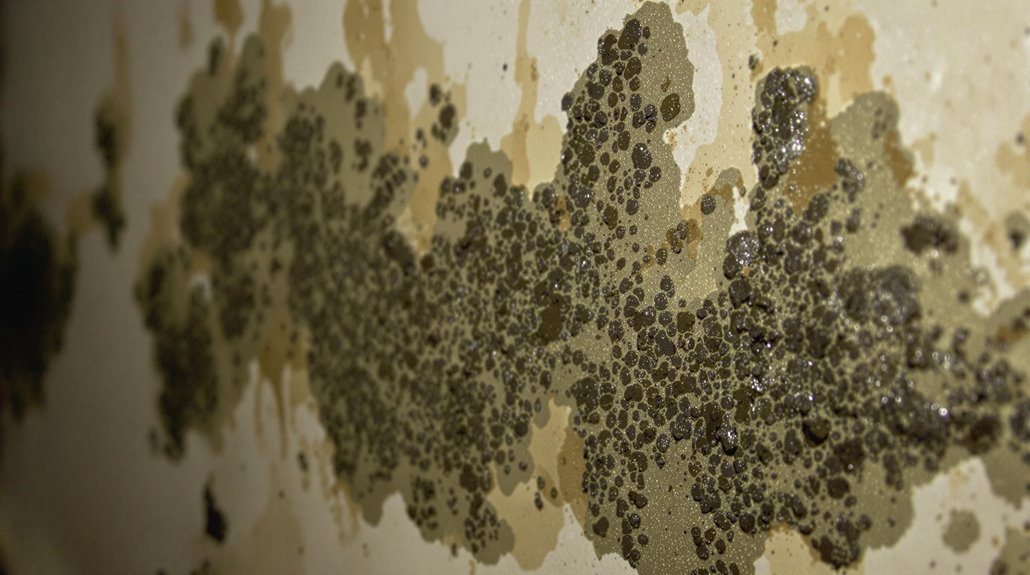
The presence of black mold in homes can often be determined through visual inspection and awareness of specific signs.
*Stachybotrys chartarum*, the most toxic black mold species, typically exhibits a distinct appearance characterized by dark green or black patches with a flat or fuzzy texture. Black mold thrives on cellulose-rich materials in damp areas, such as basements and attics.
A musty odor, often compared to decaying organic matter, can be a strong indicator of black mold presence. Visual identification is possible, as black mold can grow in clusters and may be mistaken for dirt or dust due to its dense growth pattern.
Regular mold inspections and monitoring of high-risk areas, such as bathrooms and kitchens, are vital for early detection and prevention of black mold infestations.
Identifying black mold growth is essential to mitigating the health effects of black mold exposure and preventing further damage to the home.
Maintaining humidity below 50% through proper ventilation and dehumidification is crucial for preventing black mold growth in moisture-prone areas.
Distinguishing Between Toxic and Non-Toxic Black Mold
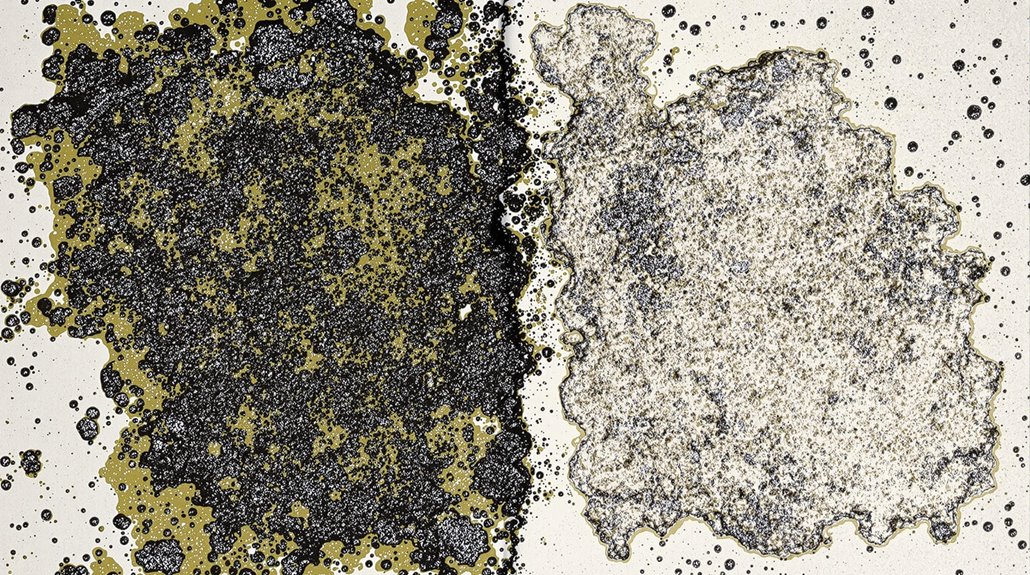
Identifying black mold in homes is only the first step in addressing potential health risks and damage. Distinguishing between toxic and non-toxic black mold is vital for effective mold remediation and mitigating health risks.
| Characteristics | Toxic Black Mold | Non-Toxic Black Mold |
|---|---|---|
| Appearance | Dark green or black | Dark green or black, but less slimy |
| Odor | Musty, decay-like smell | No distinctive smell |
| Growth Environment | Consistently humid areas | Surfaces with lesser moisture levels |
| Health Risks | Severe respiratory issues | Mild allergic reactions |
| Remediation | Professional removal recommended | Can be treated with DIY cleaning solutions |
To identify toxic black mold, careful visual inspection and professional testing may be necessary. Effective mold remediation strategies differ depending on the type of mold. Understanding the differences between toxic and non-toxic black mold is important for ensuring a safe and healthy living environment. Water-damaged buildings often create ideal conditions for toxic black mold growth within 24-48 hours of exposure.
Health Symptoms Associated With Black Mold Exposure
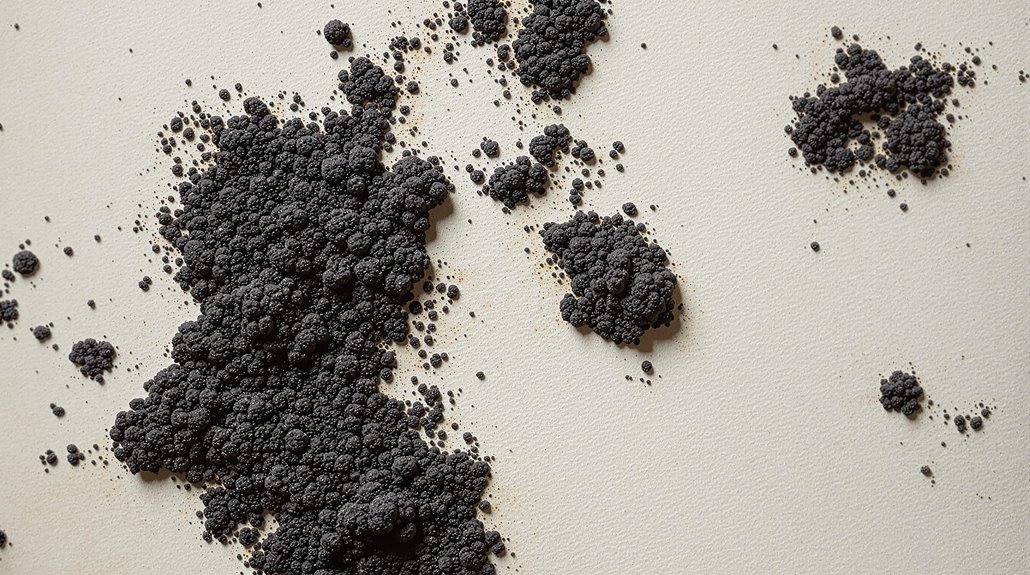
Numerous health issues can arise from exposure to black mold, ranging from mild allergic reactions to severe respiratory problems.
Respiratory symptoms such as coughing, sneezing, and nasal congestion are common, particularly affecting individuals with asthma or mold allergies. Black mold exposure can also lead to eye irritation, skin rashes, and sinus inflammation, which may worsen in sensitive individuals.
Long-term exposure can result in more severe health issues, including chronic fatigue, cognitive difficulties, and increased risk of respiratory diseases. Individuals with compromised immune systems are at a higher risk of experiencing severe health effects, including lung infections and allergic reactions.
Symptoms may initially resemble common allergies but can escalate to more serious conditions. Medical attention is necessary for persistent or worsening symptoms.
Black mold exposure poses a significant threat to human health, particularly for those with pre-existing conditions or weakened immune systems. Serious health issues can arise if exposure is not addressed promptly.
Toxic black mold produces dangerous mycotoxins that can severely impact neurological function and memory.
Common Areas Where Black Mold Grows
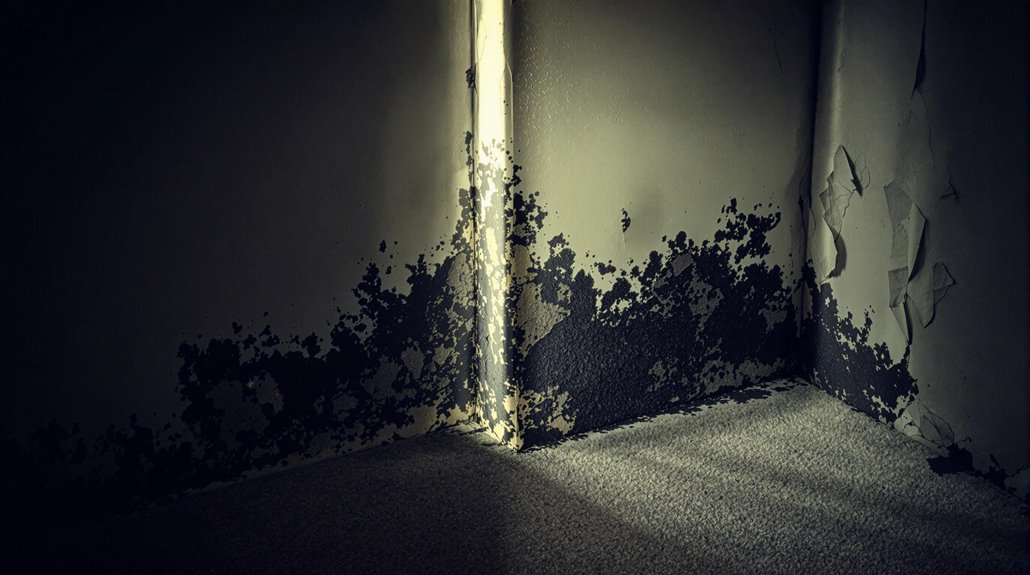
Damp environments with consistently high moisture levels create ideal breeding grounds for black mold. This type of mold, specifically *Stachybotrys chartarum*, commonly grows in areas such as bathrooms and kitchens where moisture levels are consistently high.
| Common Areas for Black Mold Growth | Indicators of Black Mold Presence |
|---|---|
| Basements, attics, and crawlspaces | Water damage, poor ventilation |
| Behind walls, under carpets, and air | Hidden moisture accumulation, musty |
| conditioning units | odors |
| Dark grout lines in tiled areas, peeling | Visible signs of moisture issues, |
| wallpaper, and warping drywall | warping or peeling surfaces |
Regular inspections of commonly neglected areas, such as vents and plumbing fixtures, can help identify early signs of mold growth before it becomes a serious problem. This is essential to maintaining good indoor air quality and preventing health issues associated with black mold exposure. Black mold thrives in spaces with 70% relative humidity and temperatures around 70°F, making proper ventilation crucial for prevention.
Causes of Black Mold Growth in Homes
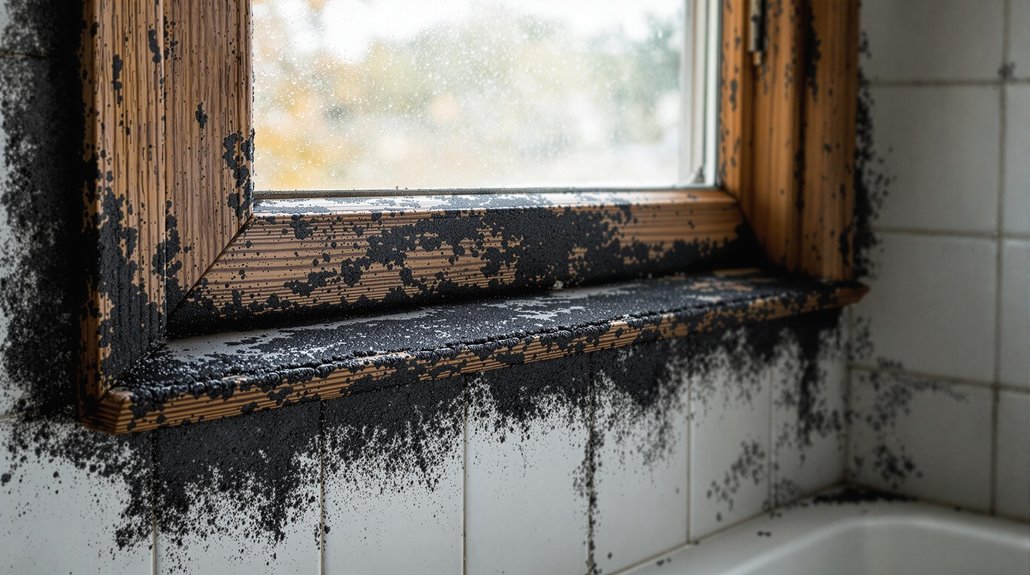
While moisture is a naturally occurring element in many homes, excessive levels can create an environment conducive to black mold growth.
The primary causes of black mold growth in homes are water intrusion from leaks, flooding, or condensation, which creates a moist environment that fosters mold proliferation.
Humid areas, particularly in southern states, are more susceptible to black mold due to higher ambient moisture levels and temperature.
Black mold requires cellulose-rich materials, such as wood, drywall, and paper, as a food source, making these materials common sites for mold growth.
Continuous moisture, such as from poorly ventilated bathrooms or damp basements, considerably increases the likelihood of black mold infestations.
The presence of water-permeable materials and inadequate ventilation in homes are critical factors that contribute to the development of black mold.
These causes highlight the importance of controlling moisture levels in the home to prevent black mold growth.
The average household produces 4 gallons of moisture daily through normal activities, making moisture control essential for preventing mold growth.
Signs of Black Mold Infestation
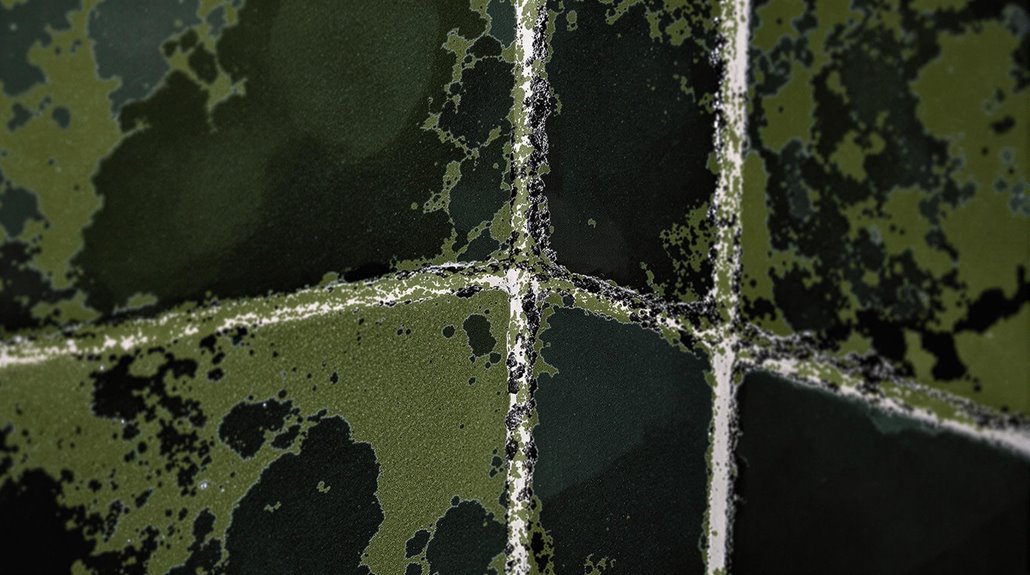
The presence of black mold in homes can be visually identified through the appearance of dark green or black patches on surfaces.
These patches often manifest in areas prone to dampness, such as bathrooms and basements, where moisture accumulates and creates an ideal environment for mold growth.
A thorough examination of these areas can reveal early signs of infestation, allowing for prompt action to mitigate the issue.
You may notice musty earthy odors similar to rotting wood or forest soil, which is a key indicator of black mold presence.
Visual Mold Identification
Careful observation is essential for identifying visual signs of black mold infestation in homes.
Black mold, scientifically known as Stachybotrys chartarum, typically appears as dark green or black with a flat or fuzzy texture on cellulose-rich materials like wood or drywall. A musty smell resembling decay or wet soil often accompanies visual signs.
Dark spots or patches on walls, ceilings, or hidden areas such as behind appliances and under sinks may indicate black mold presence. Peeling wallpaper or warping drywall can signify moisture issues, making these areas significant for inspection.
Mold thrives in damp, humid environments, so areas prone to moisture issues should be closely monitored for visual signs of infestation, including bathrooms, basements, and attics where moisture accumulates.
Visual identification is vital for early detection and remediation.
Common Growth Areas
Black mold growth is often confined to areas with elevated moisture levels, making specific locations within homes more susceptible to infestation.
Common growth areas include bathrooms, kitchens, basements, and attics, where high humidity levels and water leaks create ideal conditions for black mold to thrive.
Behind tiles, inside HVAC systems, and within wall cavities are also prone to mold development.
Poor ventilation in closed-off rooms or spaces further increases the risk of black mold growth, emphasizing the need for exhaust fans and dehumidifiers.
Homeowners should be vigilant in these areas, recognizing signs of infestation such as musty odors, dark stains, and peeling wallpaper or warping drywall.
Regular inspections are essential in identifying and addressing black mold growth in its early stages.
Professional Testing and Remediation of Black Mold
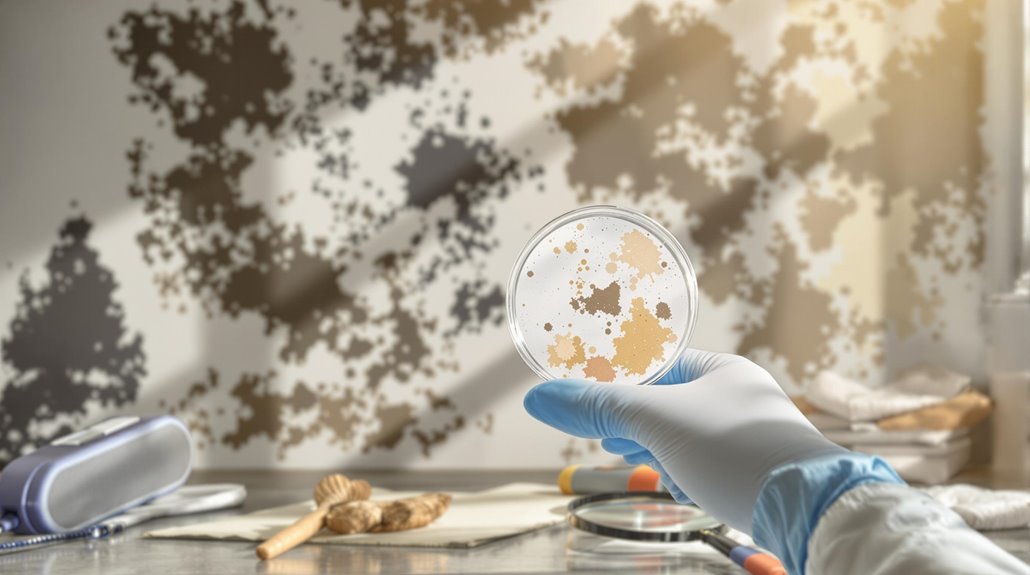
When identifying and addressing black mold infestations in homes, professional testing and remediation services play an essential role in guaranteeing accurate assessments and effective treatment.
Professional mold testing involves the use of specialized sampling kits to detect mycotoxins and mold spores in the air and on surfaces, providing a thorough assessment of indoor air quality. Visual assessments are also performed to identify potential growth areas and moisture sources that contribute to mold proliferation.
If black mold is found, professionals recommend tailored remediation strategies, including containment, removal, and repair of underlying moisture issues to prevent recurrence.
Remediation specialists use advanced equipment, such as HEPA filters, to safely clean and eliminate mold while minimizing exposure to airborne spores. Homeowners can obtain professional estimates for remediation services, guaranteeing detailed and effective treatment of mold infestations through professional mold remediation and removal.
This approach guarantees a safe and healthy indoor environment.
Preventing Black Mold Growth in Your Home
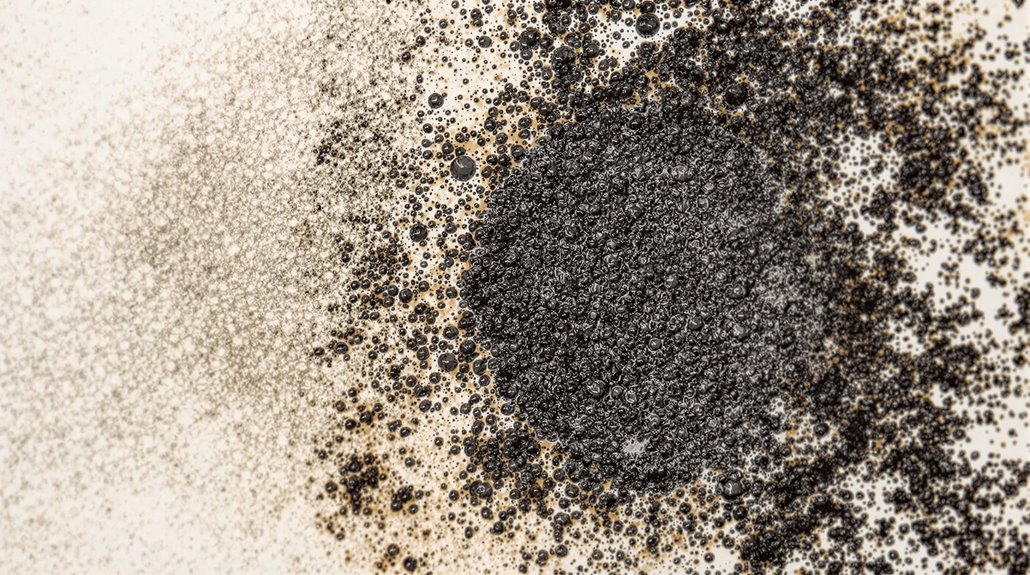
Numerous strategies can be employed to prevent black mold growth in homes, ultimately safeguarding the health and well-being of occupants.
To prevent mold, maintaining indoor humidity levels between 30% and 50% is vital, which can be achieved by using dehumidifiers and exhaust fans in moisture-prone areas like bathrooms and kitchens.
Regular inspections and prompt repairs of plumbing leaks or water damage can also mitigate the risk of a mold problem.
Proper ventilation in attics and basements, as well as discarding or professionally cleaning absorbent materials exposed to water or high humidity, can also prevent black mold from growing.
By addressing signs of mold, such as musty odors or warped drywall, homeowners can prevent the health hazards associated with mold proliferation.
By taking these steps, homeowners can prevent mold growth and avoid the need to clean the mold, ensuring a healthier living environment.
Regular vigilance is essential to prevent black mold growth.
The Benefits Of Consulting A Public Adjuster
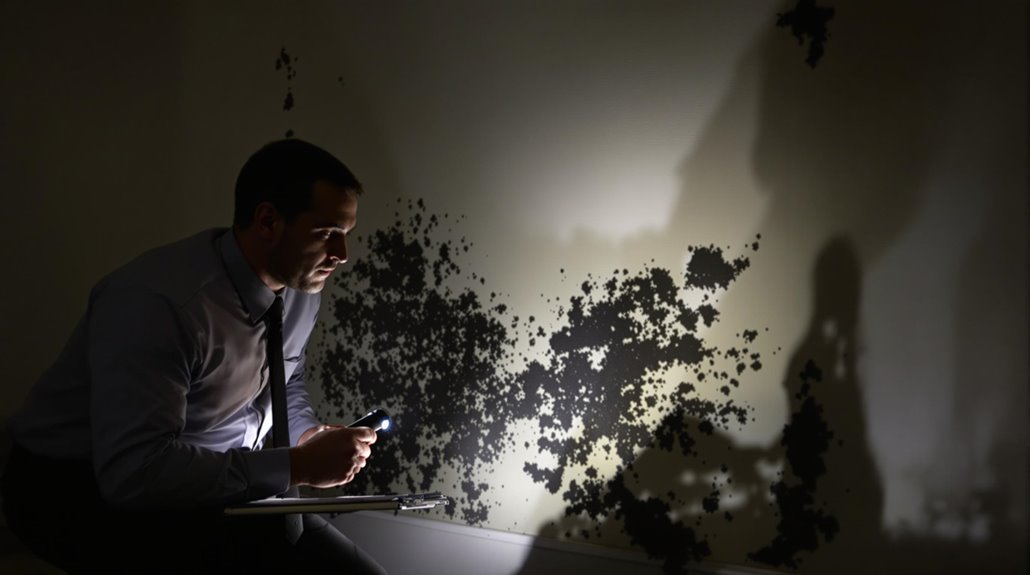
Consulting a public adjuster can provide homeowners with expertise in insurance claims, ensuring that their rights are protected and their interests are represented.
A public adjuster's objective damage assessment and knowledge of the claims process can also streamline the procedure, reducing the complexity and time required to settle a claim.
Expertise In Insurance Claims
Effective navigation of the insurance claims process is essential for homeowners dealing with mold damage. Consulting a public adjuster can provide expertise in insurance claims, ensuring fair compensation for repairs and remediation costs.
These professionals work on behalf of the policyholder, advocating for their interests and maximizing the claim settlement amount. With specialized knowledge of insurance policies, public adjusters identify applicable coverage options, including mold removal and property damage restoration.
Objective Damage Assessment
A thorough understanding of the scope and severity of mold damage is essential for successful insurance claims. Consulting a public adjuster can provide a detailed assessment of mold damage, guaranteeing that all affected areas are identified and documented.
This expertise is particularly important when dealing with black mold, which can have significant health implications for occupants of a home or business. A public adjuster can evaluate the extent of mold damage, negotiate with insurance companies, and provide valuable insights into necessary remediation steps and associated costs.
Streamlined Claim Process
When maneuvering the complex process of filing a claim for mold damage, involving a public adjuster can greatly improve the experience.
A public adjuster can streamline the claims process by ensuring all damages, including those caused by black mold, are accurately documented and presented to insurance companies. This expertise in managing complex insurance policies enables public adjusters to facilitate a smoother claims process.
By handling negotiations with insurance companies, public adjusters save homeowners time and reduce stress. They also provide valuable insights into the best evidence to support a mold-related claim, such as results from mold test kits.
This expertise increases the likelihood of a successful outcome, allowing homeowners to address mold issues and restore their homes more quickly.
Higher Claim Payouts & Settlements
Numerous studies have demonstrated that consulting a public adjuster can result in notably higher claim payouts and settlements for homeowners dealing with mold damage.
This is because public adjusters are experts in maneuvering insurance policies and can advocate for homeowners, potentially increasing settlements by 20% to 50% compared to what policyholders might receive on their own.
By accurately evaluating and documenting mold damage, including hidden mold growth, public adjusters can greatly impact the claim's value.
Working on a contingency fee basis, public adjusters' interests align with the homeowner's financial recovery.
This expertise is particularly beneficial in cases of mold infestation, where the full extent of damage may not be immediately visible.
About The Public Claims Adjusters Network (PCAN)
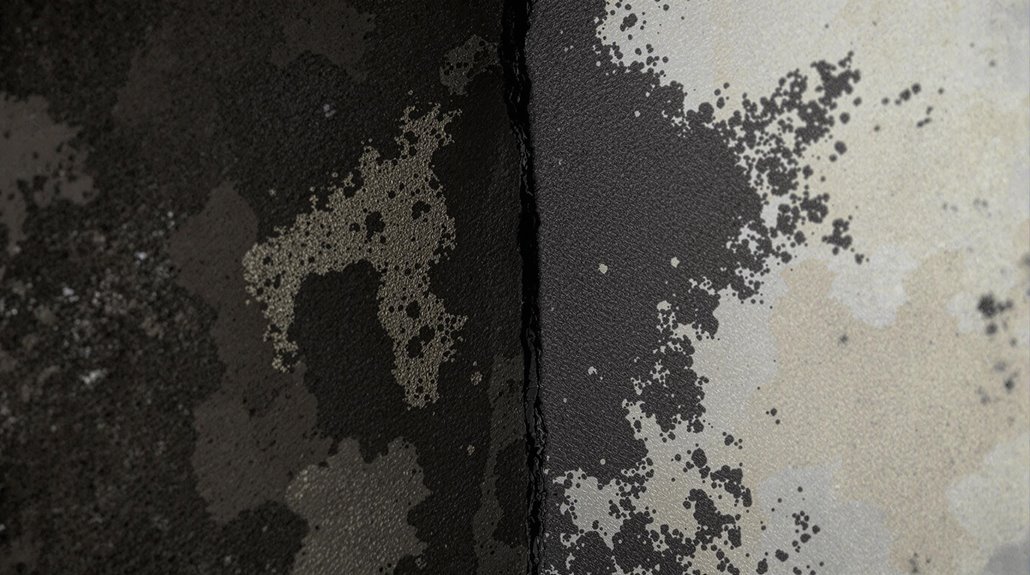
The Public Claims Adjusters Network (PCAN) is a nationwide organization comprising state-licensed public adjusters who specialize in handling residential and commercial property damage insurance claims.
PCAN serves as a resource for policyholders to connect with expert public adjusters who are pre-vetted, licensed, and experts in their field.
Some key characteristics of the Public Claims Adjusters Network (PCAN) include:
- A national network of pre-vetted, verified, and state-licensed public adjusters
- Member adjusters cover over 30 different claim types
- Members are located in 40+ states
- Mandatory yearly audits of licenses and complaints to guarantee high standards of ethics, morals, and professionalism
- An intensive application and interview process for membership, guaranteeing only the best public adjusters are admitted
PCAN connects policyholders with top public adjusters, providing assistance with property damage insurance claims and guaranteeing the highest level of expertise and professionalism.
Frequently Asked Questions
How to Tell the Difference Between Black Mold and Toxic Black Mold?
Approximately 70% of homes have mold growth. To differentiate between black mold and toxic black mold, one can employ mold identification techniques, such as observing texture and odor, and consider health effects, prompting informed mold removal methods and prevention tips.
What Does Harmless Black Mold Look Like?
Harmless black mold exhibits distinct characteristics, including dark green or black patches, fuzzy or powdery texture, and absence of a strong musty odor, distinguishing it from toxic varieties through notable mold color differences and spore types.
Is It OK to Be in House With Black Mold?
Beneath the seemingly innocuous façade of a mold-infested home, a toxic tapestry of health risks unfolds. Prolonged exposure can precipitate severe mold health effects, underscoring the importance of home safety tips, mold remediation methods, and vigilant indoor air quality monitoring.
How Long Does It Take to Get Sick From Black Mold Exposure?
Black mold symptoms can emerge within hours to days after exposure, depending on individual immune responses and the extent of mold exposure. The mold exposure timeline varies, with health effects manifesting acutely or chronically, emphasizing the need for prevention strategies.
